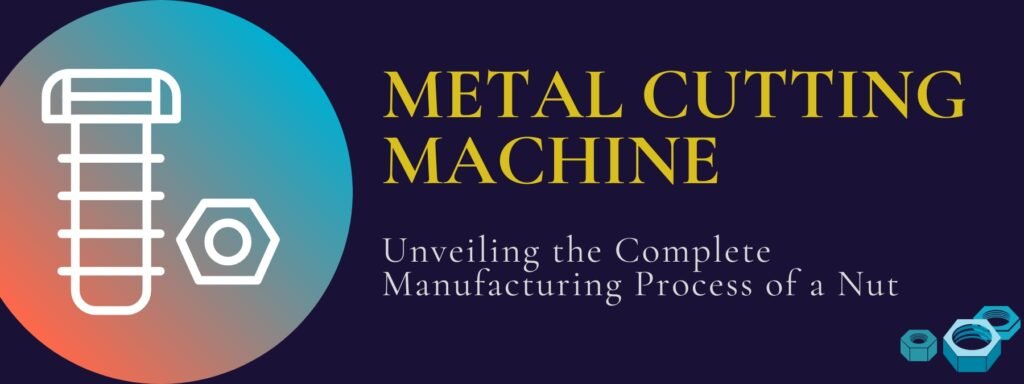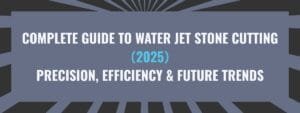Did you know that a seemingly simple nut actually undergoes multiple complex processes before becoming a precision component? Throughout these processes, metal cutting machines play an indispensable foundational role. This article will explore the manufacturing steps of a nut, the cutting methods and requirements for different metal raw material shapes, and the advantages and innovations of 5-axis waterjet cutting machines.

Application and Steps of Metal Cutting Machines in Nut Manufacturing
Metal cutting machines are fundamental equipment in nut production. From cutting metal bars to forming and precision finishing, every step relies on high-quality cutting technology. The main steps include:
- Material Preparation: Selecting carbon steel, stainless steel, or other metal bars with uniform quality and no defects;
- Cutting to Length: Using CNC metal cutting machines to cut the bars into blanks of appropriate length, with precision directly affecting subsequent forming;
- Forming Process: Cold heading or hot forging to roughly shape the nut, followed by stamping holes and chamfering;
- Precision Machining: CNC lathes trim the blanks to ensure precise thread fitting;
- Heat Treatment and Surface Finishing: Enhancing hardness and corrosion resistance;
- Final Inspection and Packaging.
Throughout this process, metal cutting machines ensure cutting precision and efficiency, laying the foundation for high-quality nuts.
Cutting Methods and Requirements for Different Metal Raw Material Shapes
Industrial metal raw materials come in various shapes, requiring tailored cutting methods:
| Metal Shape | Characteristics | Processing Requirements | Recommended Cutting Equipment |
| Metal Bars | Solid cylindrical, suitable for forming | Clean, flat cut ends without burrs | Band saw, CNC waterjet, abrasive cutting |
| Metal Plates | Various thicknesses and large areas | Fine contour cutting with minimal heat effect | Laser cutting, waterjet, plasma cutting |
| Metal Blocks | Large block shapes | High flatness, complex shape cutting | Wire cutting, waterjet |
| Metal Pipes | Hollow, various cross-sections | High-precision bevel and hole cutting | Pipe laser, rotary waterjet cutting |
| Irregular Shapes | Castings, forgings, complex geometries | Multi-axis cutting, control thermal deformation | 5-axis waterjet, 3D plasma cutting systems |
Choosing the right metal cutting machine improves cutting quality and preserves material performance.
Advantages and Applications of 5-Axis Waterjet Cutting Machines
Waterjet cutting uses a high-pressure stream of water mixed with abrasives to cut metal materials, offering several significant advantages. Compared to traditional laser or mechanical cutting, waterjet cutting produces no heat-affected zones, avoiding thermal deformation, cracks, and performance degradation—especially important for heat-sensitive materials. The process introduces almost no mechanical stress, greatly reducing part deformation and residual stress, thus improving precision and quality.
Metal Cutting Machine:Specific Advantages of Waterjet Cutting
- Cold cutting with no thermal distortion: Maintains the mechanical properties and microstructure of the material;
- Material versatility: Suitable not only for metals but also composites, ceramics, glass, foam, and other heterogeneous materials;
- High precision: Narrow kerf width and smooth edges reduce secondary processing;
- Environmentally friendly: No harmful gases or emissions during cutting;
- Flexible processing: Can handle a wide range of thicknesses from thin sheets to thick plates.
Unique Applications of 5-Axis Waterjet in Complex Shaping
Traditional 2D cutting is limited to flat surfaces. The 5-axis waterjet combines multi-axis motion with cold cutting to achieve freeform 3D cutting. This breakthrough allows precise machining of complex, irregular parts, meeting modern industry demands for diverse shapes.
- 3D Complex Surface Cutting
The 5-axis waterjet can cut at any angle, producing bevels, slopes, and curved surfaces. It’s ideal for aerospace, automotive molds, and mechanical structural components requiring high shape accuracy. - Multi-layer Composite Cutting
With coordinated Z-axis and rotary axis motion, the 5-axis waterjet cuts through stacked materials in one operation, greatly improving production efficiency. - Irregular Pipe and 3D Structure Processing
The rotary axis allows pipes and cylindrical workpieces to rotate during cutting, enabling all-around holes, bevels, and complex shape cutting, suited for sophisticated components.
Application Examples
- Aerospace: 3D cutting of wing skins and complex assembly parts for lightweight strength;
- Automotive: Complex contour and multi-angle bevel cutting of engine and body parts;
- Precision Machinery: Fine machining of molds and structural parts for improved assembly accuracy;
- High-end Hardware: Cutting of irregular handles and layered decorative parts.
With 5-axis waterjet technology, metal processing enters a multidimensional, high-precision era, fulfilling diverse industrial needs while enhancing flexibility and efficiency.
Technological Innovations in New Waterjet Systems for Diverse Processing Needs
To meet the challenges of cutting different shapes and materials, modern waterjet machines have seen multiple upgrades:
- High-pressure pumps and increased water flow for faster thick material cutting;
- Extended Z-axis travel to support 3D structural processing;
- Integrated flat and rotary axis multifunctional platforms enabling 360° rotational cutting, adapting flexibly to pipes and irregular parts;
- Intelligent control systems with automatic path planning and error compensation for improved precision and stability.
These innovations empower waterjets with greater flexibility and applicability, making them true multi-tasking tools in modern manufacturing.
Returning to Nut Manufacturing: The Indispensable Role of Waterjet Cutting
From bar cutting to forming, waterjet cutting is involved throughout nut manufacturing. Its precision, cold cutting ability, and multifunctional platforms ensure tight dimensional control and high-quality machining. Waterjets are not only key equipment for nut production but also versatile tools capable of tackling diverse complex metal processing tasks in modern industry.
This article is only for reference – for personalized assistance. Contact APW WATER JET SALES. It is every machinery provider’s obligation to help customers maximize profits.
watch water jet cutting videos / download catalogs / check technology data



